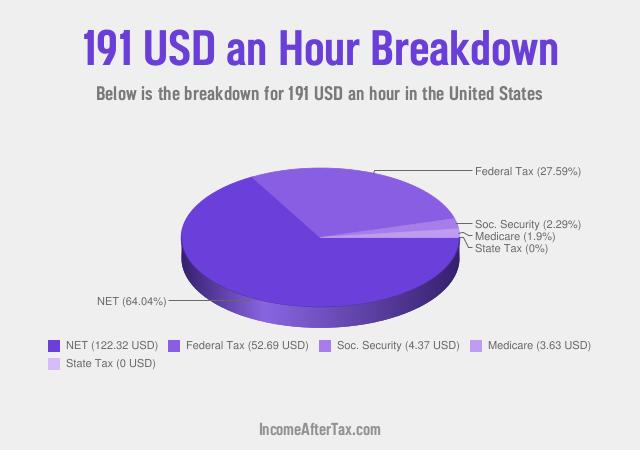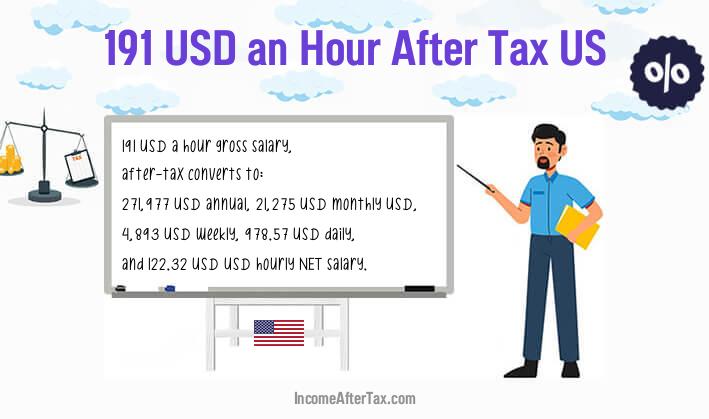The information and calculations on this page are based on your location (United States) and a zero-dollar state tax. We recommend changing the 'State' option in the calculator above if you want a more accurate version of the $191 an hour salary calculation.
How much is $191 an Hour After Tax in the United States?

In the year 2025, in the United States, $191 an hour gross salary, after-tax, is $271,977 annual, $21,275 monthly, $4,893 weekly, $978.57 daily, and $122.32 hourly gross based on the information provided in the calculator above.
Check the table below for a breakdown of $191 an hour after tax in the United States.
| Yearly | Monthly | Weekly | Daily | Hourly | |
|---|---|---|---|---|---|
| Gross Salary | $398,636 | $33,220 | $7,640 | $1,528 | $191 |
| Federal Income Tax | $109,977 | $9,165 | $2,108 | $421.55 | $52.69 |
| State Income Tax | $0 | $0 | $0 | $0 | $0 |
| Social Security | $9,114 | $759.5 | $174.67 | $34.93 | $4.37 |
| Medicare | $7,568 | $630.66 | $145.04 | $29.01 | $3.63 |
| Tax-Free Allowance | $12,950 Per Year | ||||
| Taxable Salary | $385,686 Per Year | ||||
| Take-Home Pay (NET) | $271,977 | $21,275 | $4,893 | $978.57 | $122.32 |
If you're interested in discovering how much you would earn an hour with an extra $10 added to your hourly salary, you can explore the calculations for a $201 hourly income. This will provide you with a better understanding of the difference that additional $10 can make to your hourly earnings.
$191 an Hour is How Much a Year?
$191 an hour breaks down to the following yearly salary:
- Gross (pre-tax) yearly wage of $398,636
- Take-home (NET) yearly income of $271,977
$191 an Hour is How Much a Month?
When evaluating a $191 an hour after tax income, the corresponding monthly earnings can be determined:
- Take-home (NET) monthly income: $21,275
In order to discover $191 an hour is how much a month? - simply divide the annual amount by 12, resulting in a monthly income of $21,275.
$191 an Hour is How Much a Week?
When assessing a $191 an hour after tax salary, the associated weekly earnings can be calculated:
- Take-home (NET) weekly income: $4,893
To answer $191 an hour is how much a week? - divide the annual sum by 52, resulting in a weekly income of $4,893.
$191 an Hour is How Much a Day?
When examining a $191 an hour after tax income, the corresponding daily earnings can be determined:
- Take-home (NET) daily income: $978.57 (assuming a 5-day work week)
To find out $191 an hour is how much a day? - divide the annual figure by 260 (52 weeks * 5 days), resulting in a daily income of $978.57.
Is $191 an Hour a Good Salary?
To answer if $191 an hour is a good salary. We need to compare it to the national median. After calculation using ongoing year (2025) data, the salary of $191 an hour is 5.63 times or 82.24% higher than the national median. So, is $191 an hour a good salary?
Based on comparison to the national median, yes, in our opinion, it is a very good salary in the United States.
We think these three links are helpful and related to the $191 an Hour After Tax US: 2021-2022 Tax Brackets and Federal Income Tax Rates, Taxes, and Income tax in the United States.

